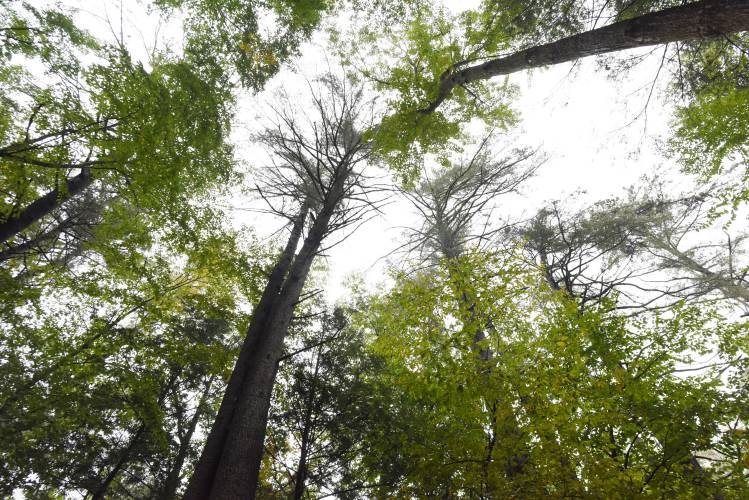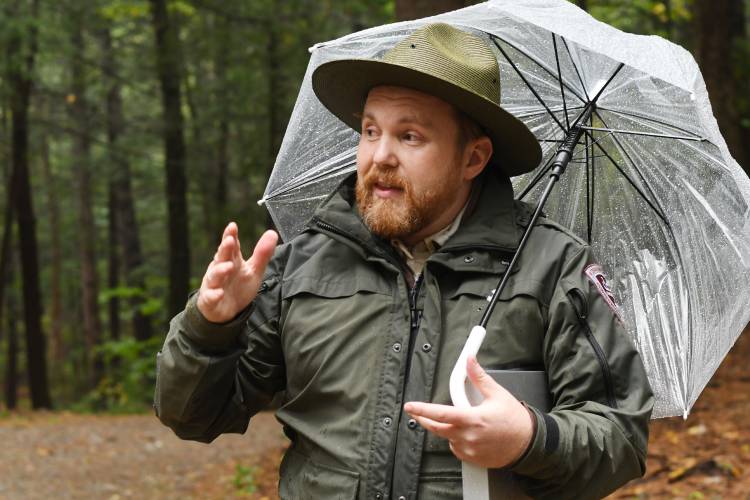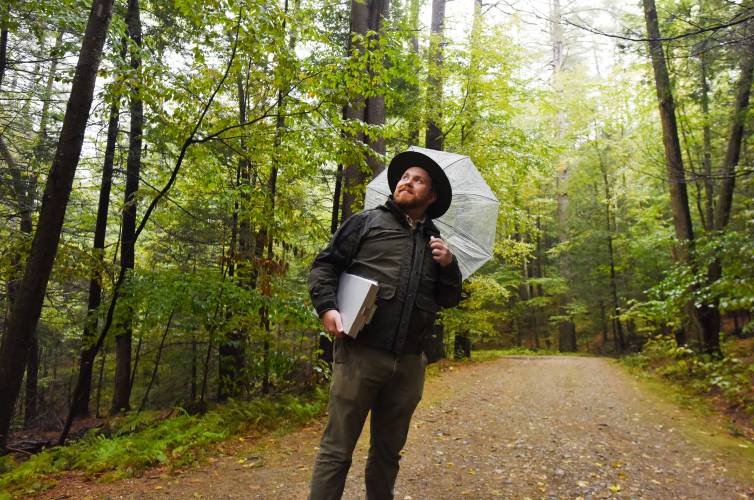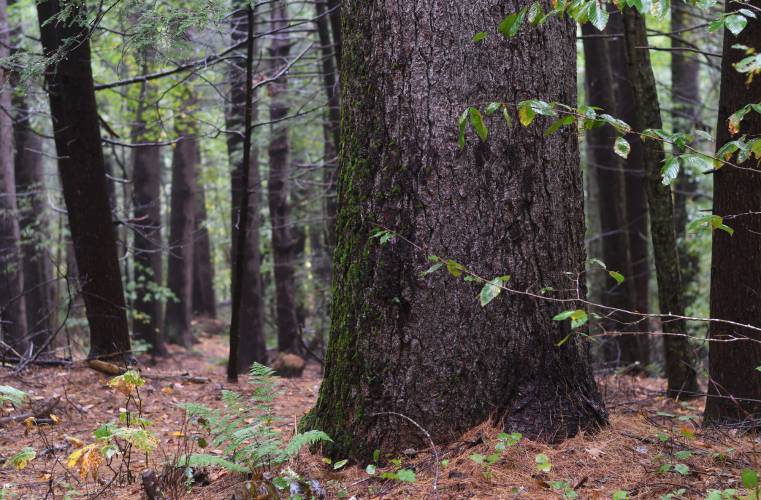Mohawk Trail State Forest harbors ‘hidden wonders’ in Trees of Peace grove
| Published: 10-04-2023 3:21 PM |
CHARLEMONT — With campsites at the Mohawk Trail State Forest closed due to water system and infrastructure repairs, park rangers have been enjoying the glory of this state gem with more solitude than in previous years.
“I have been getting people to come for some of the awe-inspiring natural marvels,” said Department of Conservation and Recreation Park Interpreter Christian Drake, noting that it can be difficult to attract visitors if they aren’t able to camp overnight.
The Mohawk Trail State Forest boasts 30 of the state’s 33 tallest trees and 17 of the tallest trees of the champion species in Massachusetts. This includes many of the trees taking superlatives as the tallest of their kind in New England, the Northeast and even east of the Mississippi River in some cases.
“If you take a second to really look at these pines from the roots to the crown, you will realize you have not seen trees taller than this since your last trip out to the redwoods,” Drake said.
The state forest is one of the older parks in Massachusetts, and many families have come there to camp for generations.
Historically, the location of a grove of tall white pines known as the Trees of Peace is a secret, with conservationists fearing that giving away such information will lead to irreparable damage by the public. In an attempt to draw more people to the park this summer, however, Drake became the first park interpreter to put the Trees of Peace on a map and lead tours directly to these regional wonders.
“If these trees are over-visited, I have made a giant mistake,” Drake said. “As a conservator, my job is to help them live until they inevitably fall. Every time someone steps into the grove it takes some time off their life.”
The Greenfield Recorder took a tour with Drake to learn more about these landmarks. By the 1840s, most of the forest in the area had been chopped down and converted to farmland.
Article continues after...
Yesterday's Most Read Articles
 Greenfield homicide victim to be memorialized in Pittsfield
Greenfield homicide victim to be memorialized in Pittsfield
 Former Greenfield man granted new trial after 1995 murder conviction, walks free
Former Greenfield man granted new trial after 1995 murder conviction, walks free
 On The Ridge with Joe Judd: What time should you turkey hunt?
On The Ridge with Joe Judd: What time should you turkey hunt?
 Judge sets bail for Millers Falls assault suspects
Judge sets bail for Millers Falls assault suspects
 Franklin Tech student welds artistic bench for French King Bridge
Franklin Tech student welds artistic bench for French King Bridge
 As I See It: Between Israel and Palestine: Which side should we be on, and why?
As I See It: Between Israel and Palestine: Which side should we be on, and why?
“Most people assume the further back in time you go, the more wilderness there is. That couldn’t be further from the truth, especially in Massachusetts,” Drake said.
The wooded areas today looked like the English countryside in the early 1800s. Settlers in Charlemont did not have the rich soils like the farmland seen low in the valley. Instead, settlers found mostly rocky soil where they lived, so grazing sheep was favored over growing vegetables. As the west opened to settlers for farming, many people abandoned their sheep pastures and left the area.
These empty fields were the perfect place for white pines to grow. Pines excel in places with lots of light, and are unable to grow in shady areas, such as within an established forest. When pines grow together, they do so all at once and act as if they are in a race to get to the top, so as not be shaded by taller trees.
“These trees here were the winners. All the others died out not getting to the light the fastest,” Drake said of the trees in the Trees of Peace grove. The narrow nature of the trees is emblematic of this race, in which they used intense growth spurts to beat out their competitors.
Robert Leverett and his wife, Jani Leveret, measured the trees and realized the grove was a spectacular sight to behold in the 1990s.
“Leverett stumbled upon the fact that these trees really are taller than anything else around,” Drake said.
The grove was established in 1992, and in 1997, Leverett invited Indigenous dignitaries to mark the Trees of Peace as a sacred site. Many of the trees have been named after tribal chiefs and conservationists. Only a couple are not named after people, including one named “Mister Blue,” after Leverett’s minivan.
The tallest tree in the grove is named Jake Swamp, after a Mohawk chief, and stands at 173.8 feet tall.
“These are truly awesome trees in the old-school Biblical version of the word,” Drake said. “When you see how tall these trees are compared to any other tree you have seen in the state.”
Drake explained these trees are a window into seeing what 200-foot-tall forests — which barely exist in the region anymore — once looked like. When the trees were first measured by Leverett, they clocked in at around 155 feet, so they have grown since then. Unfortunately, the trees are suffering from a fungus referred to as needle cast disease, so they have not grown in many years. Additionally, people stepping on top of the roots causes the dirt to compress, which negatively impacts the trees.
DCR park rangers urge visitors to stay on the man-made paths in the Mohawk Trail State Forest, so as to not cause further damage.
“Some people think if they are not standing next to the very tallest tree and can tag that in a photo, they are not connected to the place. If you are in the grove, you are connected to everything there, and any damage you do will be lasting beyond anyone’s imagination,” Drake warned.
He also explained the trees are best viewed from the path, being that people cannot see the great height and magnitude when standing directly underneath them.
“The amazing part is they are all right here,” Drake said. “They are all first succession trees, about 150 years old, and they will fall and new ones will not grow in their place.”
When these trees ultimately fall, other trees in the forest will outgrow them and smaller pines will be shaded out.
“Franklin County has all sorts of hidden wonders,” Drake continued. “The white pine is an elder in the community. I wouldn’t say this a museum because everything is growing and changing all the time, but the forest should be considered elders among the many creatures that live here.”
So, without the camping experience at the state forest, the trees still stand, although with fewer visitors this year.
“It is possible to create a perfect standing grove of trees just by letting them govern themselves without interference,” Drake said. “They could be even more majestic than they already are. That is the benefit of standing on that trail: you are not only looking at the past, you are looking at your ancestors and seeing what they would have seen. There are not many places like that left.”
Bella Levavi can be reached at blevavi@recorder.com or 413-930-4579.
An earlier version of this article incorrectly identified one of the people who initially discovered the Trees of Peace grove. Robert Leverett and his wife, Jani Leverett, measured the trees and realized the grove was a spectacular sight to behold in the 1990s.





 ‘Stand up for our democracy’: Voting rights activist John Bonifaz keynote speaker during Law Day event
‘Stand up for our democracy’: Voting rights activist John Bonifaz keynote speaker during Law Day event Doors open at Tilton Library’s temporary home at South Deerfield Congregational Church
Doors open at Tilton Library’s temporary home at South Deerfield Congregational Church DA to announce breakthrough in 1989 unsolved homicide in Warwick
DA to announce breakthrough in 1989 unsolved homicide in Warwick Mohawk Trail Regional School looks to leave audiences humming, smiling at spring musical
Mohawk Trail Regional School looks to leave audiences humming, smiling at spring musical
